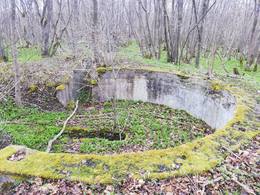Mūšiai Kiubasarėje
1941 m. surengus platų desantinį išsilaipinimą iš žemyno į Muhu pakrantę, vokiečiai išsilaipino ir pietrytinėje Saremos dalyje.
1941 m., vykdant platų vokiečių karinio jūrų laivyno desantą Muhu saloje, vokiečių kariuomenė išsilaipino ir pietryčių Saremos saloje.
Šis planas buvo veiksmingas: mažesnis specialiųjų pajėgų dalinys „Benesch“, sudarytas iš karinės žvalgybos tarnybos „Abwehr“ brandenburgiečių, rugsėjo 14 d. per netikėtą ataką turėjo užimti sovietų 43-iąją pakrantės bateriją Kiubasarėje, pietiniame Mažės sąsiaurio gale, ir sabotuoti karinio jūrų laivyno pabūklus.
Keturių 130 mm patrankų baterijai vadovavo vyresnysis leitenantas V. Bukotkinas, o jos šaudymo poligonas apėmė visą Virtsu-Kuivastu jūros kelią nuo žemyno iki salų, iki pat Kessulaido salelės. Buvo aišku, kad baterija Kiubasarėje gali sutrukdyti vokiečiams išsilaipinti Muhu saloje ir kirsti sąsiaurį, kad pasiektų Saremos salą. Todėl bateriją reikėjo kuo greičiau užimti arba sunaikinti.
Benešo dalinys, sutelkęs pajėgas, bandė vienu smūgiu užimti bateriją, tačiau operacija, sumanyta kaip staigus puolimas, baigėsi visiška nesėkme. Du trečdaliai kuopos dydžio dalinio (116 vyrų) puolė bateriją iš žvejybos laivų ir atakos laivų jūroje.
Estų valtininkų (tarp jų ir vietinio Vasili Vikato) vairuojami laivai, išplaukę iš Vaistės įlankos, dėl daugelio priežasčių nutolo nuo taikinio. Saujelę vokiečių laivuose užpuolė didelė baterijos apsaugos komanda kartu su 46-ojo šaulių pulko 1-ojo bataliono šaulių kuopa. Į krantą išlipę vokiečių kariai, padedami savo oro pajėgų, sugebėjo išgyventi iki kitos dienos. Tada jie spruko pripučiamomis valtimis, numestomis iš lėktuvų, kuriuos buvo iškvietę nelaimės metu. Jie porą dienų be tikslo dreifavo šiose valtyse, kol galiausiai buvo išgelbėti.
Pasakojama, kad kai kuriuos kareivius rusai sugavo ir po kankinimų sušaudė. Kai vokiečių 162-asis pėstininkų pulkas atvyko į Kiubasarę, sakoma, kad jie rado Benešo kareivių kūnus, kurių rankos buvo surištos spygliuota viela, o akys išdurtos durtuvais. Yra žinoma, kad rusai nužudė vieną iš kalinių, kuris buvo transportinio sklandytuvo pilotas.
Kai kurie jų tiesiog pasiklydo, o kiti buvo nustumti patrankų ugnimi. Trečdalis Benešo vyrų (44 vyrai) auštant turėjo nusileisti tiesiai baterijos teritorijoje penkiais DFS 230 transportiniais sklandytuvais, kuriuos tempė Ju 52, tačiau galiausiai nusileido į šiaurę nuo baterijos, tikriausiai dėl pilotų padarytos navigacijos klaidos. Dauguma gerai apmokytų ir vertingų specialiųjų operacijų karių buvo išgelbėti, žuvo tik 22 (12 iš jų žuvo, šeši buvo sužeisti, o keturi dingo be žinios mūšio metu). Nepaisant to, tai, kas greičiausiai buvo vienintelė desantinė desanto operacija Estijoje, buvo visiška katastrofa.
Vokiečiams nepavyko sunaikinti baterijos išsilaipinimo metu, o vėliau oro pajėgos sunaikino tris iš keturių pabūklų.
Susijusios vietos
Kübassaare 130 mm pakrantės gynybos baterija
Ši 130 mm baterija yra Kiubasario pusiasalio gale.
Nebaigtas statyti buvo keturios 130 mm 50 kalibro B13 pabūklai, kurių šaudymo nuotolis buvo 24 km, o ugnies sektorius – 166°. Įgulą turėjo sudaryti 160 vyrų (devyni sovietų karininkai, 39 puskarininkiai ir 112 Raudonojo laivyno jūrų pėstininkų), tačiau istoriniai įrašai rodo, kad 1941 m. vasario 1 d. čia buvo penki karininkai, 23 puskarininkiai ir 135 Raudonojo laivyno jūrų pėstininkai.
Kadangi kompleksas nebuvo laiku baigtas, iki šiol išliko tik betoninės karinio jūrų laivyno pabūklų pozicijos ir nebaigti statyti bunkeriai.





